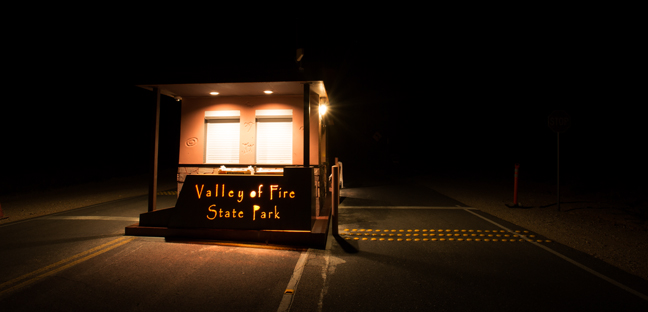

Valley of Fire State Park, NV
I don’t have a favorite National Park, a favorite place I’ve been or a favorite photograph that I’ve taken, but I do have places that I never tire of and am always challenged by and one of these is Valley of Fire State Park, located an hour northeast of Las Vegas’ McCarran International Airport.
It’s a place where you are free to roam, explore and discover and a place where light interacts with nature and constantly alters your perception. Valley of Fire is Nevada’s oldest and largest State Park and features approximately 45,000 acres of Mesozoic Era red sandstone formations. It’s the kind of place where if you stop only at the marked attractions along the Park’s two roads, you’ll miss the real beauty of the place. If you can imagine a heaven for natural arches, this is what it would look like. It’s the site of the once secretive Windstone Arch, immortalized by David Muench, who worked for Arizona Highways magazine for more than 50 years and inspired us all. The location of the fragile small arch within a cave was kept secret for years until the coordinates were published on the Internet.
There are named and unnamed formations and arches, some with multiple names and some so remote that you can imagine they’ve never been seen before and therefore name them yourself. Of course, with a little research you can find GPS coordinates for almost everything in the Park, but often it’s more fun to imagine being a member of the Civilian Conservation Corps marking new trails in the 1930s.
It's a place where light and shadow are as important as the geologic formations and a place where you can usually get a campsite and be on location for sunrises, sunsets and night sky photography. It's place that you can explore for a lifetime and make discoveries both within and outside the formal park boundaries. Nobody really knows how many natural arches are in the park, certainly hundreds and possibly thousands. Certainly enough for my lifetime.
©Rich Beckman
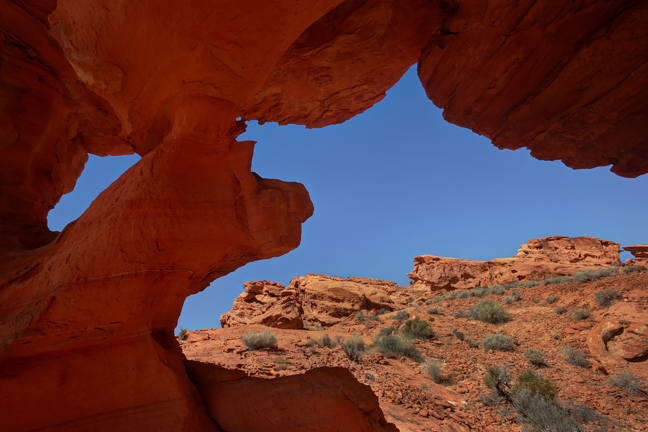

Unnamed Formation: Valley of Fire State Park, NV
I don’t have a favorite National Park, a favorite place I’ve been or a favorite photograph that I’ve taken, but I do have places that I never tire of and am always challenged by and one of those is Valley of Fire State Park, located an hour northeast of Las Vegas’ McCarran International Airport.
It’s a place where you are free to roam, explore and discover and a place where light interacts with nature and constantly alters your perception. Valley of Fire is Nevada’s oldest and largest State Park and features approximately 45,000 acres of Mesozoic Era red sandstone formations. It’s the kind of place where if you stop only at the marked attractions along the Park’s two roads, you’ll miss the real beauty of the place. If you can imagine a heaven for natural arches, this is what it would look like. It’s the site of the once secretive Windstone Arch, immortalized by David Muench, who worked for Arizona Highways magazine for more than 50 years and inspired us all. The location of the fragile small arch within a cave was kept secret for years until the coordinates were published on the Internet.
There are named and unnamed formations and arches, some with multiple names and some so remote that you can imagine they’ve never been seen before and therefore name them yourself. Of course, with a little research you can find GPS coordinates for almost everything in the Park, but often it’s more fun to imagine being a member of the Civilian Conservation Corps marking new trails in the 1930s.
It's a place where light and shadow are as important as the geologic formations and a place where you can usually get a campsite and be on location for sunrises, sunsets and night sky photography. It's place that you can explore for a lifetime and make discoveries both within and outside the formal park boundaries. Nobody really knows how many natural arches are in the park, certainly hundreds and possibly thousands. Certainly enough for my lifetime.
©Rich Beckman
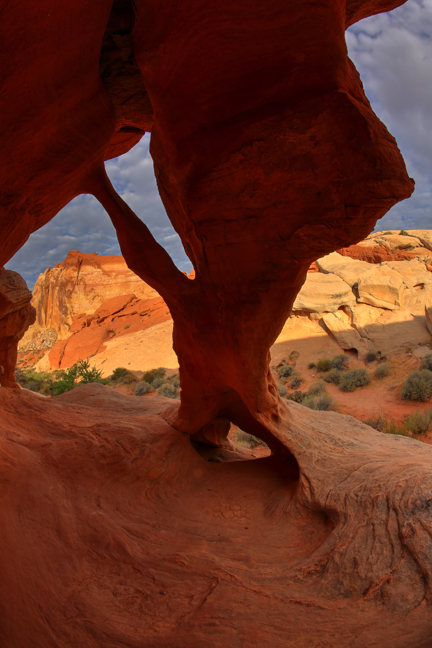

Fire Cave, Fire of Valley State Park, NV
I don’t have a favorite National Park, a favorite place I’ve been or a favorite photograph that I’ve taken, but I do have places that I never tire of and am always challenged by and one of those is Valley of Fire State Park, located an hour northeast of Las Vegas’ McCarran International Airport.
It’s a place where you are free to roam, explore and discover and a place where light interacts with nature and constantly alters your perception. Valley of Fire is Nevada’s oldest and largest State Park and features approximately 45,000 acres of Mesozoic Era red sandstone formations. It’s the kind of place where if you stop only at the marked attractions along the Park’s two roads, you’ll miss the real beauty of the place. If you can imagine a heaven for natural arches, this is what it would look like. It’s the site of the once secretive Windstone Arch, immortalized by David Muench, who worked for Arizona Highways magazine for more than 50 years and inspired us all. The location of the fragile small arch within a cave was kept secret for years until the coordinates were published on the Internet.
There are named and unnamed formations and arches, some with multiple names and some so remote that you can imagine they’ve never been seen before and therefore name them yourself. Of course, with a little research you can find GPS coordinates for almost everything in the Park, but often it’s more fun to imagine being a member of the Civilian Conservation Corps marking new trails in the 1930s.
It's a place where light and shadow are as important as the geologic formations and a place where you can usually get a campsite and be on location for sunrises, sunsets and night sky photography. It's place that you can explore for a lifetime and make discoveries both within and outside the formal park boundaries. Nobody really knows how many natural arches are in the park, certainly hundreds and possibly thousands. Certainly enough for my lifetime.
©Rich Beckman
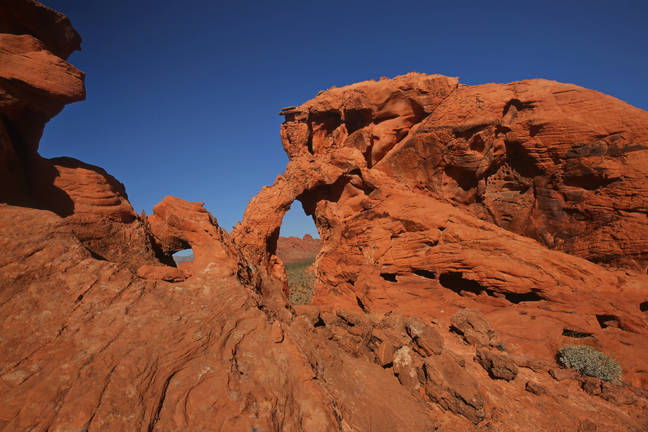

Unnamed Formation: Valley of Fire State Park, NV
I don’t have a favorite National Park, a favorite place I’ve been or a favorite photograph that I’ve taken, but I do have places that I never tire of and am always challenged by and one of those is Valley of Fire State Park, located an hour northeast of Las Vegas’ McCarran International Airport.
It’s a place where you are free to roam, explore and discover and a place where light interacts with nature and constantly alters your perception. Valley of Fire is Nevada’s oldest and largest State Park and features approximately 45,000 acres of Mesozoic Era red sandstone formations. It’s the kind of place where if you stop only at the marked attractions along the Park’s two roads, you’ll miss the real beauty of the place. If you can imagine a heaven for natural arches, this is what it would look like. It’s the site of the once secretive Windstone Arch, immortalized by David Muench, who worked for Arizona Highways magazine for more than 50 years and inspired us all. The location of the fragile small arch within a cave was kept secret for years until the coordinates were published on the Internet.
There are named and unnamed formations and arches, some with multiple names and some so remote that you can imagine they’ve never been seen before and therefore name them yourself. Of course, with a little research you can find GPS coordinates for almost everything in the Park, but often it’s more fun to imagine being a member of the Civilian Conservation Corps marking new trails in the 1930s.
It's a place where light and shadow are as important as the geologic formations and a place where you can usually get a campsite and be on location for sunrises, sunsets and night sky photography. It's place that you can explore for a lifetime and make discoveries both within and outside the formal park boundaries. Nobody really knows how many natural arches are in the park, certainly hundreds and possibly thousands. Certainly enough for my lifetime.
©Rich Beckman
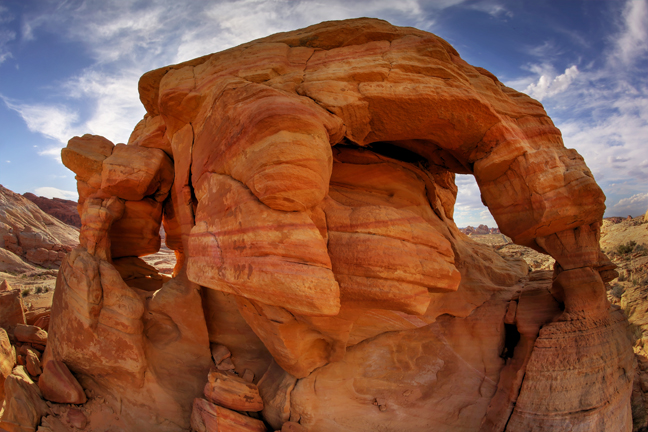

Unnamed Formation: Valley of Fire State Park, NV
I don’t have a favorite National Park, a favorite place I’ve been or a favorite photograph that I’ve taken, but I do have places that I never tire of and am always challenged by and one of those is Valley of Fire State Park, located an hour northeast of Las Vegas’ McCarran International Airport.
It’s a place where you are free to roam, explore and discover and a place where light interacts with nature and constantly alters your perception. Valley of Fire is Nevada’s oldest and largest State Park and features approximately 45,000 acres of Mesozoic Era red sandstone formations. It’s the kind of place where if you stop only at the marked attractions along the Park’s two roads, you’ll miss the real beauty of the place. If you can imagine a heaven for natural arches, this is what it would look like. It’s the site of the once secretive Windstone Arch, immortalized by David Muench, who worked for Arizona Highways magazine for more than 50 years and inspired us all. The location of the fragile small arch within a cave was kept secret for years until the coordinates were published on the Internet.
There are named and unnamed formations and arches, some with multiple names and some so remote that you can imagine they’ve never been seen before and therefore name them yourself. Of course, with a little research you can find GPS coordinates for almost everything in the Park, but often it’s more fun to imagine being a member of the Civilian Conservation Corps marking new trails in the 1930s.
It's a place where light and shadow are as important as the geologic formations and a place where you can usually get a campsite and be on location for sunrises, sunsets and night sky photography. It's place that you can explore for a lifetime and make discoveries both within and outside the formal park boundaries. Nobody really knows how many natural arches are in the park, certainly hundreds and possibly thousands. Certainly enough for my lifetime.
©Rich Beckman
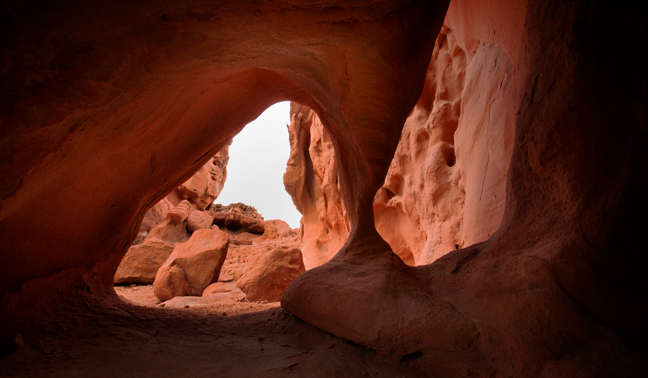

Unnamed Formation: Valley of Fire State Park, NV
I don’t have a favorite National Park, a favorite place I’ve been or a favorite photograph that I’ve taken, but I do have places that I never tire of and am always challenged by and one of those is Valley of Fire State Park, located an hour northeast of Las Vegas’ McCarran International Airport.
It’s a place where you are free to roam, explore and discover and a place where light interacts with nature and constantly alters your perception. Valley of Fire is Nevada’s oldest and largest State Park and features approximately 45,000 acres of Mesozoic Era red sandstone formations. It’s the kind of place where if you stop only at the marked attractions along the Park’s two roads, you’ll miss the real beauty of the place. If you can imagine a heaven for natural arches, this is what it would look like. It’s the site of the once secretive Windstone Arch, immortalized by David Muench, who worked for Arizona Highways magazine for more than 50 years and inspired us all. The location of the fragile small arch within a cave was kept secret for years until the coordinates were published on the Internet.
There are named and unnamed formations and arches, some with multiple names and some so remote that you can imagine they’ve never been seen before and therefore name them yourself. Of course, with a little research you can find GPS coordinates for almost everything in the Park, but often it’s more fun to imagine being a member of the Civilian Conservation Corps marking new trails in the 1930s.
It's a place where light and shadow are as important as the geologic formations and a place where you can usually get a campsite and be on location for sunrises, sunsets and night sky photography. It's place that you can explore for a lifetime and make discoveries both within and outside the formal park boundaries. Nobody really knows how many natural arches are in the park, certainly hundreds and possibly thousands. Certainly enough for my lifetime.
©Rich Beckman
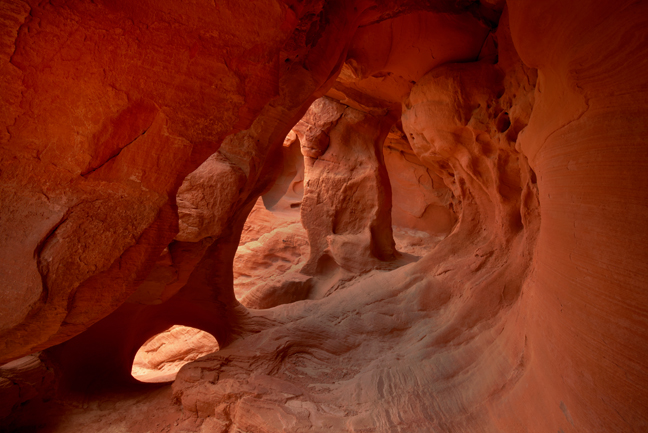

Unnamed Formation: Valley of Fire State Park, NV
I don’t have a favorite National Park, a favorite place I’ve been or a favorite photograph that I’ve taken, but I do have places that I never tire of and am always challenged by and one of those is Valley of Fire State Park, located an hour northeast of Las Vegas’ McCarran International Airport.
It’s a place where you are free to roam, explore and discover and a place where light interacts with nature and constantly alters your perception. Valley of Fire is Nevada’s oldest and largest State Park and features approximately 45,000 acres of Mesozoic Era red sandstone formations. It’s the kind of place where if you stop only at the marked attractions along the Park’s two roads, you’ll miss the real beauty of the place. If you can imagine a heaven for natural arches, this is what it would look like. It’s the site of the once secretive Windstone Arch, immortalized by David Muench, who worked for Arizona Highways magazine for more than 50 years and inspired us all. The location of the fragile small arch within a cave was kept secret for years until the coordinates were published on the Internet.
There are named and unnamed formations and arches, some with multiple names and some so remote that you can imagine they’ve never been seen before and therefore name them yourself. Of course, with a little research you can find GPS coordinates for almost everything in the Park, but often it’s more fun to imagine being a member of the Civilian Conservation Corps marking new trails in the 1930s.
It's a place where light and shadow are as important as the geologic formations and a place where you can usually get a campsite and be on location for sunrises, sunsets and night sky photography. It's place that you can explore for a lifetime and make discoveries both within and outside the formal park boundaries. Nobody really knows how many natural arches are in the park, certainly hundreds and possibly thousands. Certainly enough for my lifetime.
©Rich Beckman
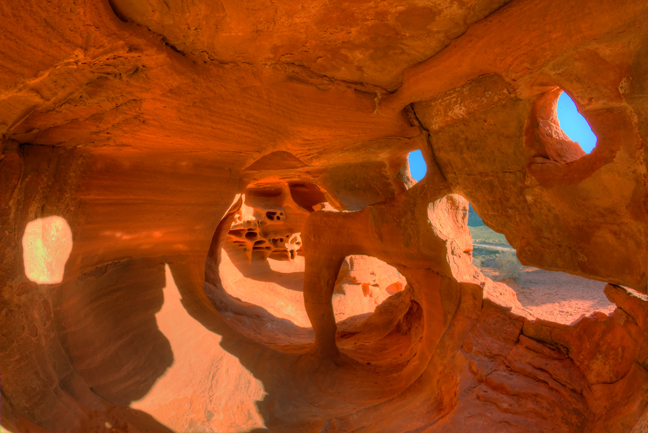

Windstone Arch (12S 719318-4032476, 36°24'44.85"N, 114°33'14.37"W), Valley of Fire State Park, NV
I don’t have a favorite National Park, a favorite place I’ve been or a favorite photograph that I’ve taken, but I do have places that I never tire of and am always challenged by and one of those is Valley of Fire State Park, located an hour northeast of Las Vegas’ McCarran International Airport.
It’s a place where you are free to roam, explore and discover and a place where light interacts with nature and constantly alters your perception. Valley of Fire is Nevada’s oldest and largest State Park and features approximately 45,000 acres of Mesozoic Era red sandstone formations. It’s the kind of place where if you stop only at the marked attractions along the Park’s two roads, you’ll miss the real beauty of the place. If you can imagine a heaven for natural arches, this is what it would look like. It’s the site of the once secretive Windstone Arch, immortalized by David Muench, who worked for Arizona Highways magazine for more than 50 years and inspired us all. The location of the fragile small arch within a cave was kept secret for years until the coordinates were published on the Internet.
There are named and unnamed formations and arches, some with multiple names and some so remote that you can imagine they’ve never been seen before and therefore name them yourself. Of course, with a little research you can find GPS coordinates for almost everything in the Park, but often it’s more fun to imagine being a member of the Civilian Conservation Corps marking new trails in the 1930s.
It's a place where light and shadow are as important as the geologic formations and a place where you can usually get a campsite and be on location for sunrises, sunsets and night sky photography. It's place that you can explore for a lifetime and make discoveries both within and outside the formal park boundaries. Nobody really knows how many natural arches are in the park, certainly hundreds and possibly thousands. Certainly enough for my lifetime.
©Rich Beckman
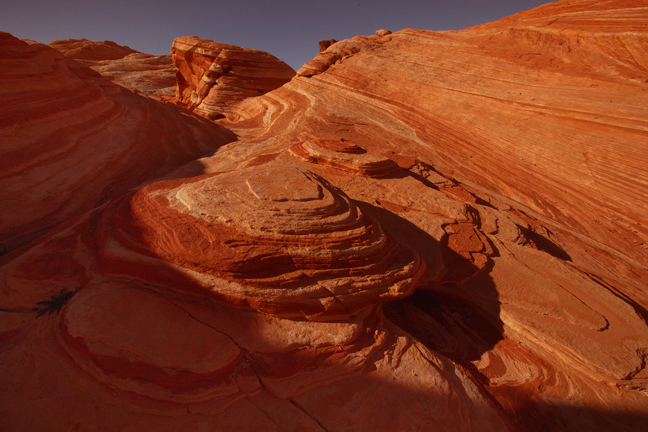

Fire Wave: Valley of Fire State Park, NV
I don’t have a favorite National Park, a favorite place I’ve been or a favorite photograph that I’ve taken, but I do have places that I never tire of and am always challenged by and one of those is Valley of Fire State Park, located an hour northeast of Las Vegas’ McCarran International Airport.
It’s a place where you are free to roam, explore and discover and a place where light interacts with nature and constantly alters your perception. Valley of Fire is Nevada’s oldest and largest State Park and features approximately 45,000 acres of Mesozoic Era red sandstone formations. It’s the kind of place where if you stop only at the marked attractions along the Park’s two roads, you’ll miss the real beauty of the place. If you can imagine a heaven for natural arches, this is what it would look like. It’s the site of the once secretive Windstone Arch, immortalized by David Muench, who worked for Arizona Highways magazine for more than 50 years and inspired us all. The location of the fragile small arch within a cave was kept secret for years until the coordinates were published on the Internet.
There are named and unnamed formations and arches, some with multiple names and some so remote that you can imagine they’ve never been seen before and therefore name them yourself. Of course, with a little research you can find GPS coordinates for almost everything in the Park, but often it’s more fun to imagine being a member of the Civilian Conservation Corps marking new trails in the 1930s.
It's a place where light and shadow are as important as the geologic formations and a place where you can usually get a campsite and be on location for sunrises, sunsets and night sky photography. It's place that you can explore for a lifetime and make discoveries both within and outside the formal park boundaries. Nobody really knows how many natural arches are in the park, certainly hundreds and possibly thousands. Certainly enough for my lifetime.
©Rich Beckman
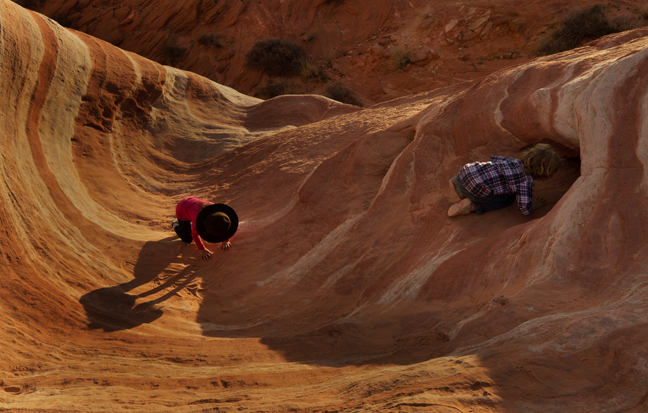

Fire Wave: Valley of Fire State Park, NV
I don’t have a favorite National Park, a favorite place I’ve been or a favorite photograph that I’ve taken, but I do have places that I never tire of and am always challenged by and one of those is Valley of Fire State Park, located an hour northeast of Las Vegas’ McCarran International Airport.
It’s a place where you are free to roam, explore and discover and a place where light interacts with nature and constantly alters your perception. Valley of Fire is Nevada’s oldest and largest State Park and features approximately 45,000 acres of Mesozoic Era red sandstone formations. It’s the kind of place where if you stop only at the marked attractions along the Park’s two roads, you’ll miss the real beauty of the place. If you can imagine a heaven for natural arches, this is what it would look like. It’s the site of the once secretive Windstone Arch, immortalized by David Muench, who worked for Arizona Highways magazine for more than 50 years and inspired us all. The location of the fragile small arch within a cave was kept secret for years until the coordinates were published on the Internet.
There are named and unnamed formations and arches, some with multiple names and some so remote that you can imagine they’ve never been seen before and therefore name them yourself. Of course, with a little research you can find GPS coordinates for almost everything in the Park, but often it’s more fun to imagine being a member of the Civilian Conservation Corps marking new trails in the 1930s.
It's a place where light and shadow are as important as the geologic formations and a place where you can usually get a campsite and be on location for sunrises, sunsets and night sky photography. It's place that you can explore for a lifetime and make discoveries both within and outside the formal park boundaries. Nobody really knows how many natural arches are in the park, certainly hundreds and possibly thousands. Certainly enough for my lifetime.
©Rich Beckman
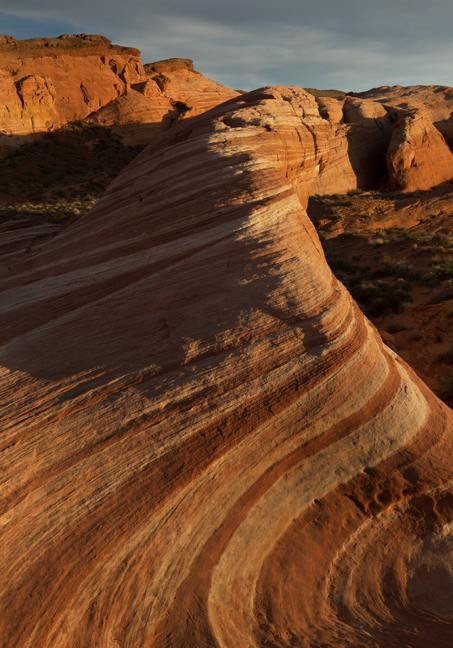

Fire Wave, Fire of Valley State Park, NV
I don’t have a favorite National Park, a favorite place I’ve been or a favorite photograph that I’ve taken, but I do have places that I never tire of and am always challenged by and one of those is Valley of Fire State Park, located an hour northeast of Las Vegas’ McCarran International Airport.
It’s a place where you are free to roam, explore and discover and a place where light interacts with nature and constantly alters your perception. Valley of Fire is Nevada’s oldest and largest State Park and features approximately 45,000 acres of Mesozoic Era red sandstone formations. It’s the kind of place where if you stop only at the marked attractions along the Park’s two roads, you’ll miss the real beauty of the place. If you can imagine a heaven for natural arches, this is what it would look like. It’s the site of the once secretive Windstone Arch, immortalized by David Muench, who worked for Arizona Highways magazine for more than 50 years and inspired us all. The location of the fragile small arch within a cave was kept secret for years until the coordinates were published on the Internet.
There are named and unnamed formations and arches, some with multiple names and some so remote that you can imagine they’ve never been seen before and therefore name them yourself. Of course, with a little research you can find GPS coordinates for almost everything in the Park, but often it’s more fun to imagine being a member of the Civilian Conservation Corps marking new trails in the 1930s.
It's a place where light and shadow are as important as the geologic formations and a place where you can usually get a campsite and be on location for sunrises, sunsets and night sky photography. It's place that you can explore for a lifetime and make discoveries both within and outside the formal park boundaries. Nobody really knows how many natural arches are in the park, certainly hundreds and possibly thousands. Certainly enough for my lifetime.
©Rich Beckman
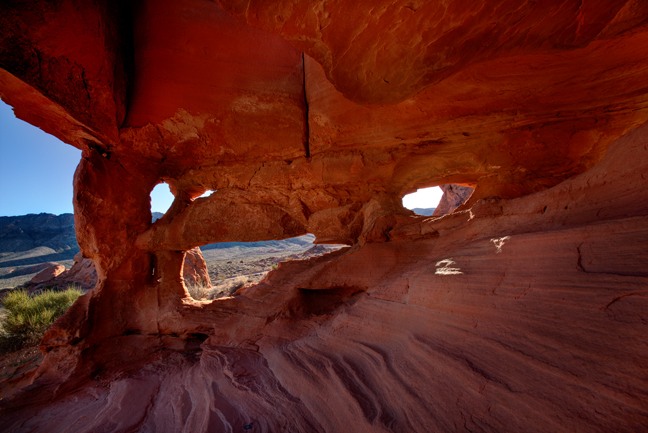

Table Arch: Valley of Fire State Park, NV
I don’t have a favorite National Park, a favorite place I’ve been or a favorite photograph that I’ve taken, but I do have places that I never tire of and am always challenged by and one of those is Valley of Fire State Park, located an hour northeast of Las Vegas’ McCarran International Airport.
It’s a place where you are free to roam, explore and discover and a place where light interacts with nature and constantly alters your perception. Valley of Fire is Nevada’s oldest and largest State Park and features approximately 45,000 acres of Mesozoic Era red sandstone formations. It’s the kind of place where if you stop only at the marked attractions along the Park’s two roads, you’ll miss the real beauty of the place. If you can imagine a heaven for natural arches, this is what it would look like. It’s the site of the once secretive Windstone Arch, immortalized by David Muench, who worked for Arizona Highways magazine for more than 50 years and inspired us all. The location of the fragile small arch within a cave was kept secret for years until the coordinates were published on the Internet.
There are named and unnamed formations and arches, some with multiple names and some so remote that you can imagine they’ve never been seen before and therefore name them yourself. Of course, with a little research you can find GPS coordinates for almost everything in the Park, but often it’s more fun to imagine being a member of the Civilian Conservation Corps marking new trails in the 1930s.
It's a place where light and shadow are as important as the geologic formations and a place where you can usually get a campsite and be on location for sunrises, sunsets and night sky photography. It's place that you can explore for a lifetime and make discoveries both within and outside the formal park boundaries. Nobody really knows how many natural arches are in the park, certainly hundreds and possibly thousands. Certainly enough for my lifetime.
©Rich Beckman
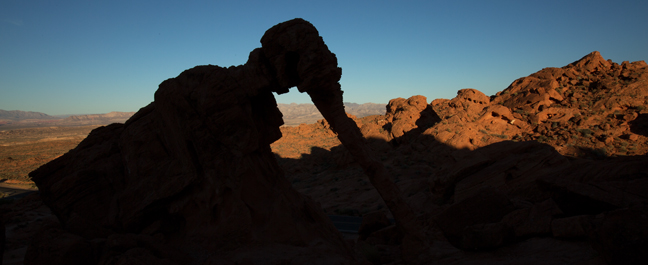

Elephant Rock, Valley of Fire State Park, NV
I don’t have a favorite National Park, a favorite place I’ve been or a favorite photograph that I’ve taken, but I do have places that I never tire of and am always challenged by and one of those is Valley of Fire State Park, located an hour northeast of Las Vegas’ McCarran International Airport.
It’s a place where you are free to roam, explore and discover and a place where light interacts with nature and constantly alters your perception. Valley of Fire is Nevada’s oldest and largest State Park and features approximately 45,000 acres of Mesozoic Era red sandstone formations. It’s the kind of place where if you stop only at the marked attractions along the Park’s two roads, you’ll miss the real beauty of the place. If you can imagine a heaven for natural arches, this is what it would look like. It’s the site of the once secretive Windstone Arch, immortalized by David Muench, who worked for Arizona Highways magazine for more than 50 years and inspired us all. The location of the fragile small arch within a cave was kept secret for years until the coordinates were published on the Internet.
There are named and unnamed formations and arches, some with multiple names and some so remote that you can imagine they’ve never been seen before and therefore name them yourself. Of course, with a little research you can find GPS coordinates for almost everything in the Park, but often it’s more fun to imagine being a member of the Civilian Conservation Corps marking new trails in the 1930s.
It's a place where light and shadow are as important as the geologic formations and a place where you can usually get a campsite and be on location for sunrises, sunsets and night sky photography. It's place that you can explore for a lifetime and make discoveries both within and outside the formal park boundaries. Nobody really knows how many natural arches are in the park, certainly hundreds and possibly thousands. Certainly enough for my lifetime.
©Rich Beckman
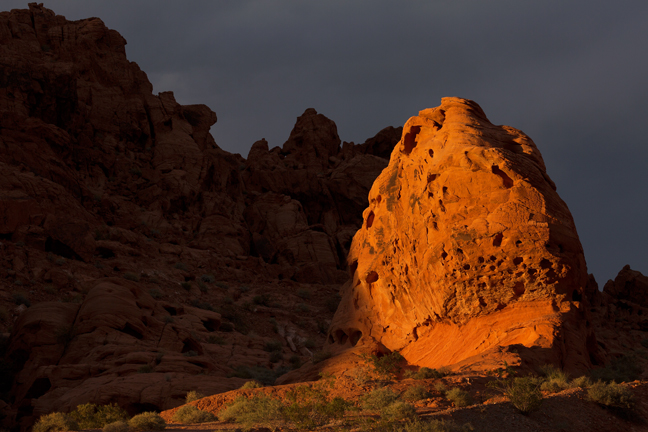

Beehive Formation: Valley of Fire State Park, NV
I don’t have a favorite National Park, a favorite place I’ve been or a favorite photograph that I’ve taken, but I do have places that I never tire of and am always challenged by and one of those is Valley of Fire State Park, located an hour northeast of Las Vegas’ McCarran International Airport.
It’s a place where you are free to roam, explore and discover and a place where light interacts with nature and constantly alters your perception. Valley of Fire is Nevada’s oldest and largest State Park and features approximately 45,000 acres of Mesozoic Era red sandstone formations. It’s the kind of place where if you stop only at the marked attractions along the Park’s two roads, you’ll miss the real beauty of the place. If you can imagine a heaven for natural arches, this is what it would look like. It’s the site of the once secretive Windstone Arch, immortalized by David Muench, who worked for Arizona Highways magazine for more than 50 years and inspired us all. The location of the fragile small arch within a cave was kept secret for years until the coordinates were published on the Internet.
There are named and unnamed formations and arches, some with multiple names and some so remote that you can imagine they’ve never been seen before and therefore name them yourself. Of course, with a little research you can find GPS coordinates for almost everything in the Park, but often it’s more fun to imagine being a member of the Civilian Conservation Corps marking new trails in the 1930s.
It's a place where light and shadow are as important as the geologic formations and a place where you can usually get a campsite and be on location for sunrises, sunsets and night sky photography. It's place that you can explore for a lifetime and make discoveries both within and outside the formal park boundaries. Nobody really knows how many natural arches are in the park, certainly hundreds and possibly thousands. Certainly enough for my lifetime.
©Rich Beckman
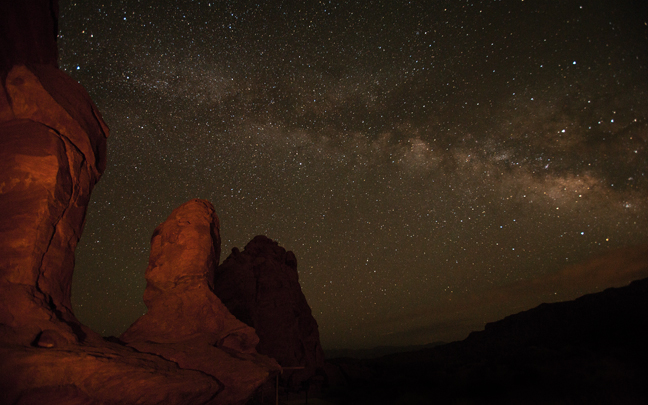

Milky Way, Seven Sisters, Valley of Fire State Park, NV
I don’t have a favorite National Park, a favorite place I’ve been or a favorite photograph that I’ve taken, but I do have places that I never tire of and am always challenged by and one of those is Valley of Fire State Park, located an hour northeast of Las Vegas’ McCarran International Airport.
It’s a place where you are free to roam, explore and discover and a place where light interacts with nature and constantly alters your perception. Valley of Fire is Nevada’s oldest and largest State Park and features approximately 45,000 acres of Mesozoic Era red sandstone formations. It’s the kind of place where if you stop only at the marked attractions along the Park’s two roads, you’ll miss the real beauty of the place. If you can imagine a heaven for natural arches, this is what it would look like. It’s the site of the once secretive Windstone Arch, immortalized by David Muench, who worked for Arizona Highways magazine for more than 50 years and inspired us all. The location of the fragile small arch within a cave was kept secret for years until the coordinates were published on the Internet.
There are named and unnamed formations and arches, some with multiple names and some so remote that you can imagine they’ve never been seen before and therefore name them yourself. Of course, with a little research you can find GPS coordinates for almost everything in the Park, but often it’s more fun to imagine being a member of the Civilian Conservation Corps marking new trails in the 1930s.
It's a place where light and shadow are as important as the geologic formations and a place where you can usually get a campsite and be on location for sunrises, sunsets and night sky photography. It's place that you can explore for a lifetime and make discoveries both within and outside the formal park boundaries. Nobody really knows how many natural arches are in the park, certainly hundreds and possibly thousands. Certainly enough for my lifetime.
©Rich Beckman
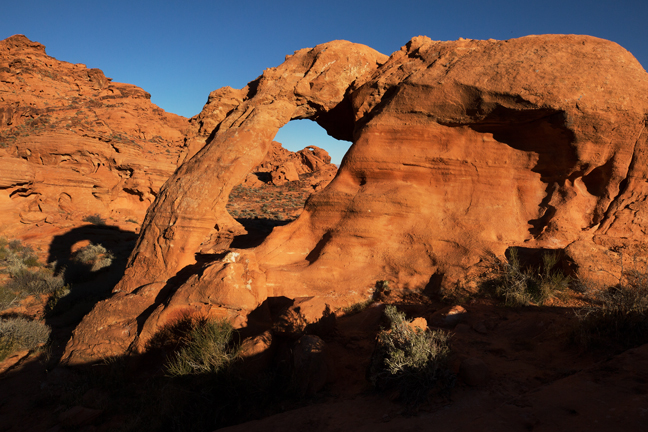

Unnamed Formation, Valley of Fire State Park, NV
I don’t have a favorite National Park, a favorite place I’ve been or a favorite photograph that I’ve taken, but I do have places that I never tire of and am always challenged by and one of those is Valley of Fire State Park, located an hour northeast of Las Vegas’ McCarran International Airport.
It’s a place where you are free to roam, explore and discover and a place where light interacts with nature and constantly alters your perception. Valley of Fire is Nevada’s oldest and largest State Park and features approximately 45,000 acres of Mesozoic Era red sandstone formations. It’s the kind of place where if you stop only at the marked attractions along the Park’s two roads, you’ll miss the real beauty of the place. If you can imagine a heaven for natural arches, this is what it would look like. It’s the site of the once secretive Windstone Arch, immortalized by David Muench, who worked for Arizona Highways magazine for more than 50 years and inspired us all. The location of the fragile small arch within a cave was kept secret for years until the coordinates were published on the Internet.
There are named and unnamed formations and arches, some with multiple names and some so remote that you can imagine they’ve never been seen before and therefore name them yourself. Of course, with a little research you can find GPS coordinates for almost everything in the Park, but often it’s more fun to imagine being a member of the Civilian Conservation Corps marking new trails in the 1930s.
It's a place where light and shadow are as important as the geologic formations and a place where you can usually get a campsite and be on location for sunrises, sunsets and night sky photography. It's place that you can explore for a lifetime and make discoveries both within and outside the formal park boundaries. Nobody really knows how many natural arches are in the park, certainly hundreds and possibly thousands. Certainly enough for my lifetime.
©Rich Beckman
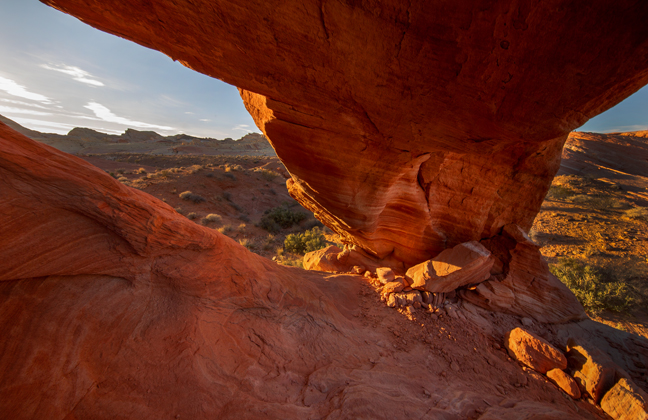

Unnamed Formation, Valley of Fire State Park, NV
I don’t have a favorite National Park, a favorite place I’ve been or a favorite photograph that I’ve taken, but I do have places that I never tire of and am always challenged by and one of those is Valley of Fire State Park, located an hour northeast of Las Vegas’ McCarran International Airport.
It’s a place where you are free to roam, explore and discover and a place where light interacts with nature and constantly alters your perception. Valley of Fire is Nevada’s oldest and largest State Park and features approximately 45,000 acres of Mesozoic Era red sandstone formations. It’s the kind of place where if you stop only at the marked attractions along the Park’s two roads, you’ll miss the real beauty of the place. If you can imagine a heaven for natural arches, this is what it would look like. It’s the site of the once secretive Windstone Arch, immortalized by David Muench, who worked for Arizona Highways magazine for more than 50 years and inspired us all. The location of the fragile small arch within a cave was kept secret for years until the coordinates were published on the Internet.
There are named and unnamed formations and arches, some with multiple names and some so remote that you can imagine they’ve never been seen before and therefore name them yourself. Of course, with a little research you can find GPS coordinates for almost everything in the Park, but often it’s more fun to imagine being a member of the Civilian Conservation Corps marking new trails in the 1930s.
It's a place where light and shadow are as important as the geologic formations and a place where you can usually get a campsite and be on location for sunrises, sunsets and night sky photography. It's place that you can explore for a lifetime and make discoveries both within and outside the formal park boundaries. Nobody really knows how many natural arches are in the park, certainly hundreds and possibly thousands. Certainly enough for my lifetime.
©Rich Beckman
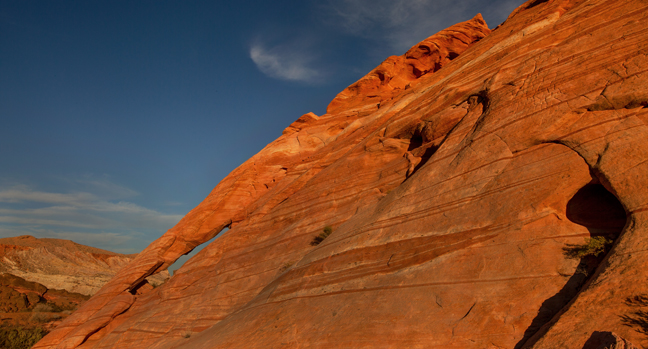

Arch at Fire Wave, Valley of Fire State Park, NV
I don’t have a favorite National Park, a favorite place I’ve been or a favorite photograph that I’ve taken, but I do have places that I never tire of and am always challenged by and one of those is Valley of Fire State Park, located an hour northeast of Las Vegas’ McCarran International Airport.
It’s a place where you are free to roam, explore and discover and a place where light interacts with nature and constantly alters your perception. Valley of Fire is Nevada’s oldest and largest State Park and features approximately 45,000 acres of Mesozoic Era red sandstone formations. It’s the kind of place where if you stop only at the marked attractions along the Park’s two roads, you’ll miss the real beauty of the place. If you can imagine a heaven for natural arches, this is what it would look like. It’s the site of the once secretive Windstone Arch, immortalized by David Muench, who worked for Arizona Highways magazine for more than 50 years and inspired us all. The location of the fragile small arch within a cave was kept secret for years until the coordinates were published on the Internet.
There are named and unnamed formations and arches, some with multiple names and some so remote that you can imagine they’ve never been seen before and therefore name them yourself. Of course, with a little research you can find GPS coordinates for almost everything in the Park, but often it’s more fun to imagine being a member of the Civilian Conservation Corps marking new trails in the 1930s.
It's a place where light and shadow are as important as the geologic formations and a place where you can usually get a campsite and be on location for sunrises, sunsets and night sky photography. It's place that you can explore for a lifetime and make discoveries both within and outside the formal park boundaries. Nobody really knows how many natural arches are in the park, certainly hundreds and possibly thousands. Certainly enough for my lifetime.
©Rich Beckman
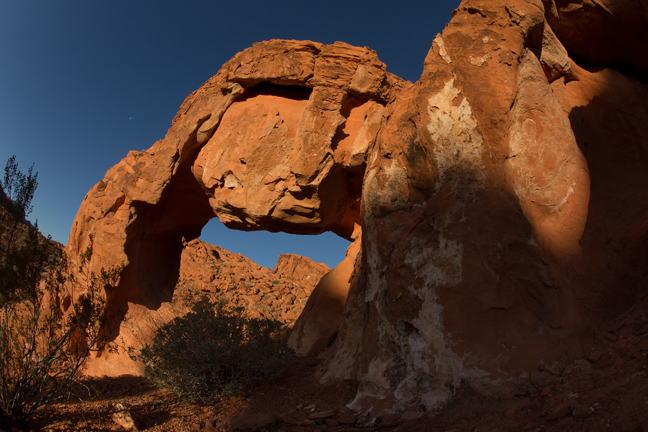

Unnamed Formation, Valley of Fire State Park, NV
I don’t have a favorite National Park, a favorite place I’ve been or a favorite photograph that I’ve taken, but I do have places that I never tire of and am always challenged by and one of those is Valley of Fire State Park, located an hour northeast of Las Vegas’ McCarran International Airport.
It’s a place where you are free to roam, explore and discover and a place where light interacts with nature and constantly alters your perception. Valley of Fire is Nevada’s oldest and largest State Park and features approximately 45,000 acres of Mesozoic Era red sandstone formations. It’s the kind of place where if you stop only at the marked attractions along the Park’s two roads, you’ll miss the real beauty of the place. If you can imagine a heaven for natural arches, this is what it would look like. It’s the site of the once secretive Windstone Arch, immortalized by David Muench, who worked for Arizona Highways magazine for more than 50 years and inspired us all. The location of the fragile small arch within a cave was kept secret for years until the coordinates were published on the Internet.
There are named and unnamed formations and arches, some with multiple names and some so remote that you can imagine they’ve never been seen before and therefore name them yourself. Of course, with a little research you can find GPS coordinates for almost everything in the Park, but often it’s more fun to imagine being a member of the Civilian Conservation Corps marking new trails in the 1930s.
It's a place where light and shadow are as important as the geologic formations and a place where you can usually get a campsite and be on location for sunrises, sunsets and night sky photography. It's place that you can explore for a lifetime and make discoveries both within and outside the formal park boundaries. Nobody really knows how many natural arches are in the park, certainly hundreds and possibly thousands. Certainly enough for my lifetime.
©Rich Beckman
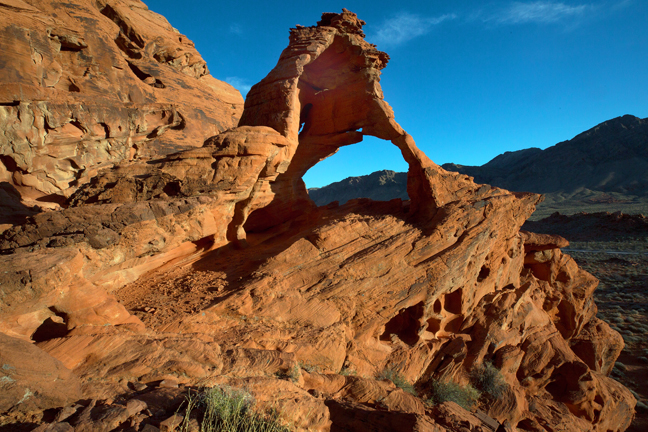

Pagoda Arch (36°24'51"N, 114°33'24"W), Valley of Fire State Park, NV
I don’t have a favorite National Park, a favorite place I’ve been or a favorite photograph that I’ve taken, but I do have places that I never tire of and am always challenged by and one of those is Valley of Fire State Park, located an hour northeast of Las Vegas’ McCarran International Airport.
It’s a place where you are free to roam, explore and discover and a place where light interacts with nature and constantly alters your perception. Valley of Fire is Nevada’s oldest and largest State Park and features approximately 45,000 acres of Mesozoic Era red sandstone formations. It’s the kind of place where if you stop only at the marked attractions along the Park’s two roads, you’ll miss the real beauty of the place. If you can imagine a heaven for natural arches, this is what it would look like. It’s the site of the once secretive Windstone Arch, immortalized by David Muench, who worked for Arizona Highways magazine for more than 50 years and inspired us all. The location of the fragile small arch within a cave was kept secret for years until the coordinates were published on the Internet.
There are named and unnamed formations and arches, some with multiple names and some so remote that you can imagine they’ve never been seen before and therefore name them yourself. Of course, with a little research you can find GPS coordinates for almost everything in the Park, but often it’s more fun to imagine being a member of the Civilian Conservation Corps marking new trails in the 1930s.
It's a place where light and shadow are as important as the geologic formations and a place where you can usually get a campsite and be on location for sunrises, sunsets and night sky photography. It's place that you can explore for a lifetime and make discoveries both within and outside the formal park boundaries. Nobody really knows how many natural arches are in the park, certainly hundreds and possibly thousands. Certainly enough for my lifetime.
©Rich Beckman
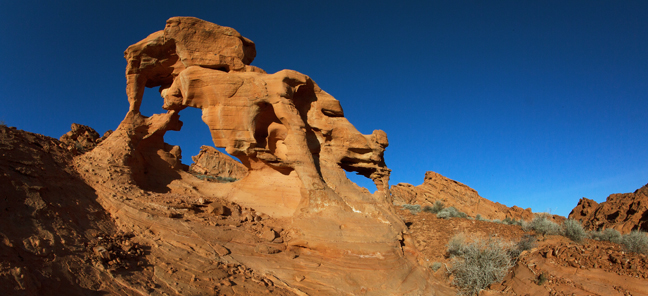

Praying Mantis Arch (12S 728218-4035527, 36°26'27.1"N, 114°27'23.2"W), Valley of Fire State Park, NV
I don’t have a favorite National Park, a favorite place I’ve been or a favorite photograph that I’ve taken, but I do have places that I never tire of and am always challenged by and one of those is Valley of Fire State Park, located an hour northeast of Las Vegas’ McCarran International Airport.
It’s a place where you are free to roam, explore and discover and a place where light interacts with nature and constantly alters your perception. Valley of Fire is Nevada’s oldest and largest State Park and features approximately 45,000 acres of Mesozoic Era red sandstone formations. It’s the kind of place where if you stop only at the marked attractions along the Park’s two roads, you’ll miss the real beauty of the place. If you can imagine a heaven for natural arches, this is what it would look like. It’s the site of the once secretive Windstone Arch, immortalized by David Muench, who worked for Arizona Highways magazine for more than 50 years and inspired us all. The location of the fragile small arch within a cave was kept secret for years until the coordinates were published on the Internet.
There are named and unnamed formations and arches, some with multiple names and some so remote that you can imagine they’ve never been seen before and therefore name them yourself. Of course, with a little research you can find GPS coordinates for almost everything in the Park, but often it’s more fun to imagine being a member of the Civilian Conservation Corps marking new trails in the 1930s.
It's a place where light and shadow are as important as the geologic formations and a place where you can usually get a campsite and be on location for sunrises, sunsets and night sky photography. It's place that you can explore for a lifetime and make discoveries both within and outside the formal park boundaries. Nobody really knows how many natural arches are in the park, certainly hundreds and possibly thousands. Certainly enough for my lifetime.
©Rich Beckman
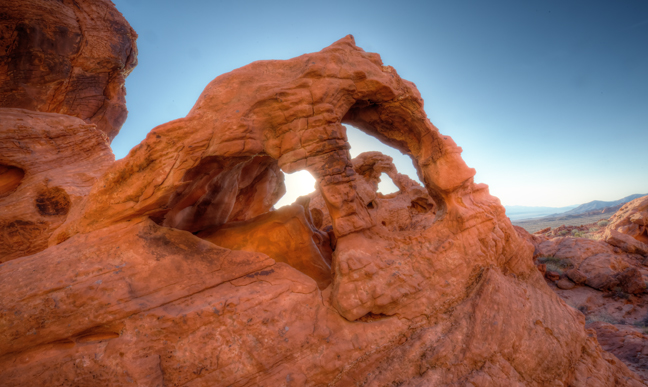

Pretzel Arch (36°26'25.4"N, 114°27'41.5"W), Valley of Fire State Park, NV
I don’t have a favorite National Park, a favorite place I’ve been or a favorite photograph that I’ve taken, but I do have places that I never tire of and am always challenged by and one of those is Valley of Fire State Park, located an hour northeast of Las Vegas’ McCarran International Airport.
It’s a place where you are free to roam, explore and discover and a place where light interacts with nature and constantly alters your perception. Valley of Fire is Nevada’s oldest and largest State Park and features approximately 45,000 acres of Mesozoic Era red sandstone formations. It’s the kind of place where if you stop only at the marked attractions along the Park’s two roads, you’ll miss the real beauty of the place. If you can imagine a heaven for natural arches, this is what it would look like. It’s the site of the once secretive Windstone Arch, immortalized by David Muench, who worked for Arizona Highways magazine for more than 50 years and inspired us all. The location of the fragile small arch within a cave was kept secret for years until the coordinates were published on the Internet.
There are named and unnamed formations and arches, some with multiple names and some so remote that you can imagine they’ve never been seen before and therefore name them yourself. Of course, with a little research you can find GPS coordinates for almost everything in the Park, but often it’s more fun to imagine being a member of the Civilian Conservation Corps marking new trails in the 1930s.
It's a place where light and shadow are as important as the geologic formations and a place where you can usually get a campsite and be on location for sunrises, sunsets and night sky photography. It's place that you can explore for a lifetime and make discoveries both within and outside the formal park boundaries. Nobody really knows how many natural arches are in the park, certainly hundreds and possibly thousands. Certainly enough for my lifetime.
©Rich Beckman
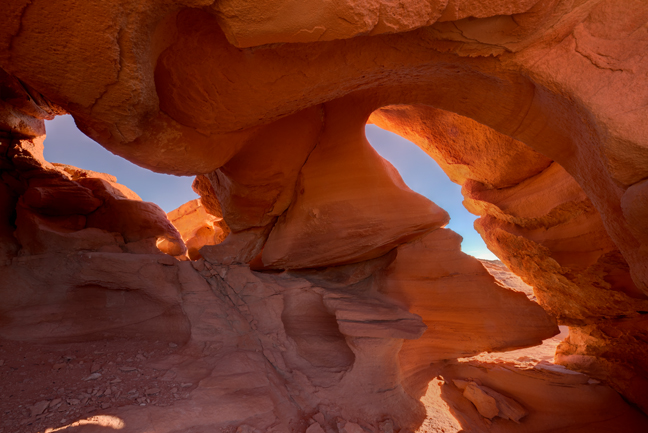

Unnamed Formation, Valley of Fire State Park, NV
I don’t have a favorite National Park, a favorite place I’ve been or a favorite photograph that I’ve taken, but I do have places that I never tire of and am always challenged by and one of those is Valley of Fire State Park, located an hour northeast of Las Vegas’ McCarran International Airport.
It’s a place where you are free to roam, explore and discover and a place where light interacts with nature and constantly alters your perception. Valley of Fire is Nevada’s oldest and largest State Park and features approximately 45,000 acres of Mesozoic Era red sandstone formations. It’s the kind of place where if you stop only at the marked attractions along the Park’s two roads, you’ll miss the real beauty of the place. If you can imagine a heaven for natural arches, this is what it would look like. It’s the site of the once secretive Windstone Arch, immortalized by David Muench, who worked for Arizona Highways magazine for more than 50 years and inspired us all. The location of the fragile small arch within a cave was kept secret for years until the coordinates were published on the Internet.
There are named and unnamed formations and arches, some with multiple names and some so remote that you can imagine they’ve never been seen before and therefore name them yourself. Of course, with a little research you can find GPS coordinates for almost everything in the Park, but often it’s more fun to imagine being a member of the Civilian Conservation Corps marking new trails in the 1930s.
It's a place where light and shadow are as important as the geologic formations and a place where you can usually get a campsite and be on location for sunrises, sunsets and night sky photography. It's place that you can explore for a lifetime and make discoveries both within and outside the formal park boundaries. Nobody really knows how many natural arches are in the park, certainly hundreds and possibly thousands. Certainly enough for my lifetime.
©Rich Beckman
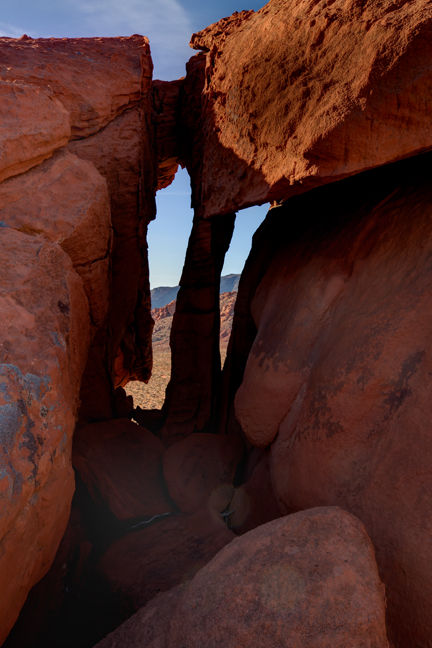

Unnamed Formation, (36°26'41.8"N, 114°27'65.3"W), Fire of Valley State Park, NV
I don’t have a favorite National Park, a favorite place I’ve been or a favorite photograph that I’ve taken, but I do have places that I never tire of and am always challenged by and one of those is Valley of Fire State Park, located an hour northeast of Las Vegas’ McCarran International Airport.
It’s a place where you are free to roam, explore and discover and a place where light interacts with nature and constantly alters your perception. Valley of Fire is Nevada’s oldest and largest State Park and features approximately 45,000 acres of Mesozoic Era red sandstone formations. It’s the kind of place where if you stop only at the marked attractions along the Park’s two roads, you’ll miss the real beauty of the place. If you can imagine a heaven for natural arches, this is what it would look like. It’s the site of the once secretive Windstone Arch, immortalized by David Muench, who worked for Arizona Highways magazine for more than 50 years and inspired us all. The location of the fragile small arch within a cave was kept secret for years until the coordinates were published on the Internet.
There are named and unnamed formations and arches, some with multiple names and some so remote that you can imagine they’ve never been seen before and therefore name them yourself. Of course, with a little research you can find GPS coordinates for almost everything in the Park, but often it’s more fun to imagine being a member of the Civilian Conservation Corps marking new trails in the 1930s.
It's a place where light and shadow are as important as the geologic formations and a place where you can usually get a campsite and be on location for sunrises, sunsets and night sky photography. It's place that you can explore for a lifetime and make discoveries both within and outside the formal park boundaries. Nobody really knows how many natural arches are in the park, certainly hundreds and possibly thousands. Certainly enough for my lifetime.
©Rich Beckman
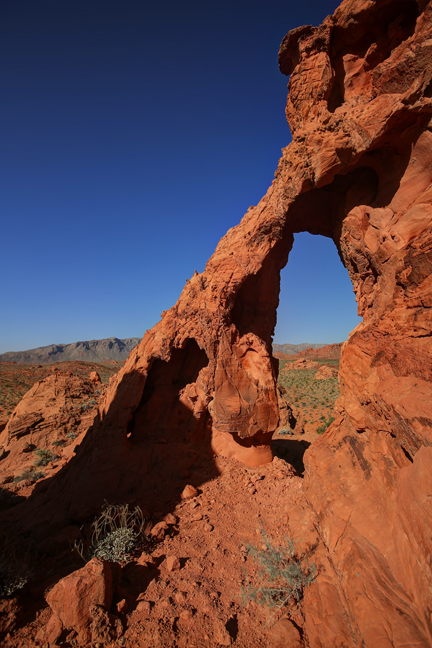

Unnamed Formation, Fire of Valley State Park, NV
I don’t have a favorite National Park, a favorite place I’ve been or a favorite photograph that I’ve taken, but I do have places that I never tire of and am always challenged by and one of those is Valley of Fire State Park, located an hour northeast of Las Vegas’ McCarran International Airport.
It’s a place where you are free to roam, explore and discover and a place where light interacts with nature and constantly alters your perception. Valley of Fire is Nevada’s oldest and largest State Park and features approximately 45,000 acres of Mesozoic Era red sandstone formations. It’s the kind of place where if you stop only at the marked attractions along the Park’s two roads, you’ll miss the real beauty of the place. If you can imagine a heaven for natural arches, this is what it would look like. It’s the site of the once secretive Windstone Arch, immortalized by David Muench, who worked for Arizona Highways magazine for more than 50 years and inspired us all. The location of the fragile small arch within a cave was kept secret for years until the coordinates were published on the Internet.
There are named and unnamed formations and arches, some with multiple names and some so remote that you can imagine they’ve never been seen before and therefore name them yourself. Of course, with a little research you can find GPS coordinates for almost everything in the Park, but often it’s more fun to imagine being a member of the Civilian Conservation Corps marking new trails in the 1930s.
It's a place where light and shadow are as important as the geologic formations and a place where you can usually get a campsite and be on location for sunrises, sunsets and night sky photography. It's place that you can explore for a lifetime and make discoveries both within and outside the formal park boundaries. Nobody really knows how many natural arches are in the park, certainly hundreds and possibly thousands. Certainly enough for my lifetime.
©Rich Beckman
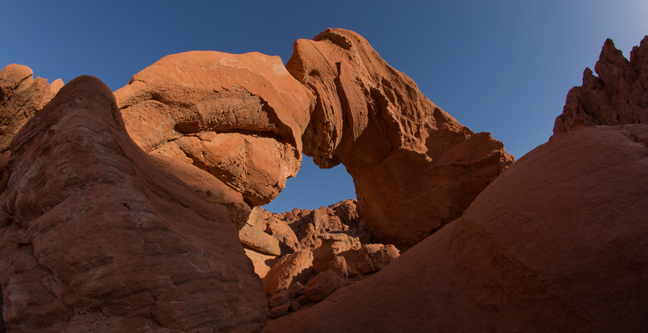

Unnamed Formation, Valley of Fire State Park, NV
I don’t have a favorite National Park, a favorite place I’ve been or a favorite photograph that I’ve taken, but I do have places that I never tire of and am always challenged by and one of those is Valley of Fire State Park, located an hour northeast of Las Vegas’ McCarran International Airport.
It’s a place where you are free to roam, explore and discover and a place where light interacts with nature and constantly alters your perception. Valley of Fire is Nevada’s oldest and largest State Park and features approximately 45,000 acres of Mesozoic Era red sandstone formations. It’s the kind of place where if you stop only at the marked attractions along the Park’s two roads, you’ll miss the real beauty of the place. If you can imagine a heaven for natural arches, this is what it would look like. It’s the site of the once secretive Windstone Arch, immortalized by David Muench, who worked for Arizona Highways magazine for more than 50 years and inspired us all. The location of the fragile small arch within a cave was kept secret for years until the coordinates were published on the Internet.
There are named and unnamed formations and arches, some with multiple names and some so remote that you can imagine they’ve never been seen before and therefore name them yourself. Of course, with a little research you can find GPS coordinates for almost everything in the Park, but often it’s more fun to imagine being a member of the Civilian Conservation Corps marking new trails in the 1930s.
It's a place where light and shadow are as important as the geologic formations and a place where you can usually get a campsite and be on location for sunrises, sunsets and night sky photography. It's place that you can explore for a lifetime and make discoveries both within and outside the formal park boundaries. Nobody really knows how many natural arches are in the park, certainly hundreds and possibly thousands. Certainly enough for my lifetime.
©Rich Beckman